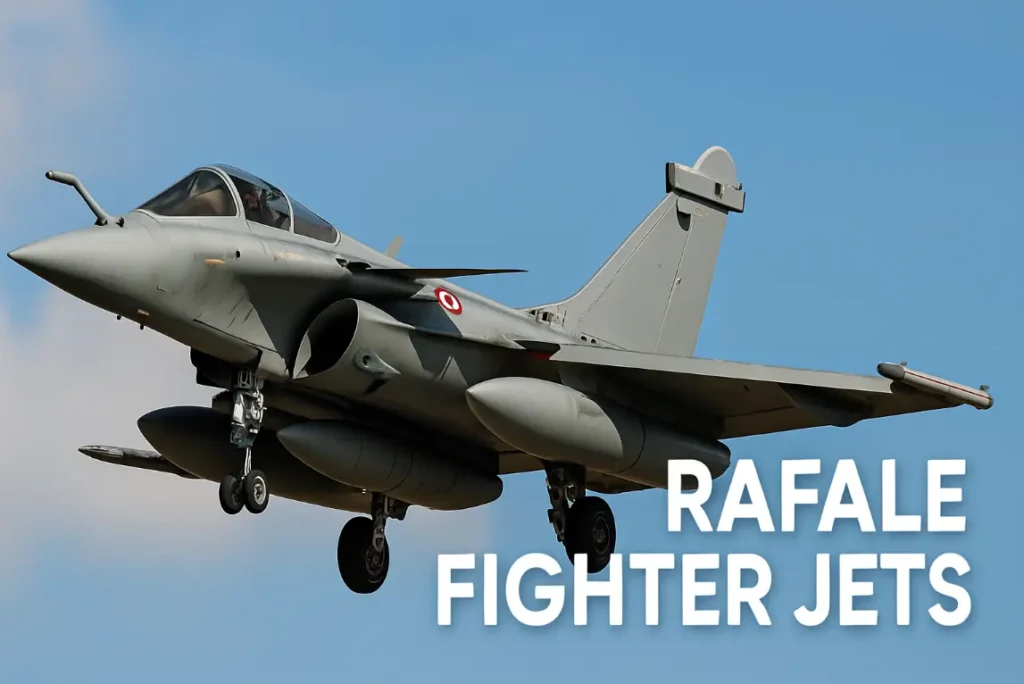The Rafale fighter jet is one of the most advanced and powerful aircraft in the world today. Built by the French company Dassault Aviation, the Rafale is a twin-engine, multirole fighter jet. That means it can perform a variety of tasks — from air-to-air combat to ground strikes, and even surveillance missions.
India has inducted the Rafale into its air force, and many defense experts call it a game-changer. In 2025, the Rafale is more relevant than ever due to rising security needs and its unmatched performance.
Key Features
Here are some of the main reasons the Rafale stands out:
- Multirole Capabilities: It can do multiple jobs — fight enemy jets, bomb ground targets, and collect intel — all in one mission.
- Advanced Radar System: The RBE2 AESA radar can detect targets from far away and track many of them at once.
- Stealth Design: The shape of the aircraft and materials used help it avoid enemy radar.
- Electronic Warfare Suite: It can jam enemy radar and missiles with its “SPECTRA” system.
- High Agility: It can perform sharp turns and complex maneuvers with ease.
These features make the Rafale one of the best in its class.

Also Read: S-400 Missile System: The Powerhouse of Air Defense in 2025
Performance & Engine
Let’s talk about what’s under the hood — or in this case, under the wings.
The Rafale is powered by two Snecma M88 engines, which give it a top speed of around Mach 1.8 (about 2,222 km/h). That’s nearly twice the speed of sound!
It has a combat range of around 1,850 km, meaning it can go deep into enemy territory and return without needing to refuel. It can also carry more than 9 tons of weapons — including air-to-air missiles, air-to-ground bombs, and even nuclear weapons if needed.
Design & Looks
The Rafale is sleek and modern. It has a delta wing design (triangular wings) and canards (small wings near the front). This design helps it remain stable while flying at high speeds and during sharp turns.
Its body is made from composite materials that make it strong but lightweight, which helps it fly faster and farther. The cockpit is digital with a heads-up display (HUD), touch controls, and night-vision compatibility.
From any angle, it just looks like a machine built for dominance.
Mileage & Efficiency
Aircraft don’t have mileage like cars, but they do have fuel efficiency and range. The Rafale is mid-air refueling capable, which extends its range significantly. Without refueling, it can fly about 3,700 km with external tanks.
For missions, it balances fuel efficiency with performance using its advanced flight systems. It can cruise at high speeds without burning too much fuel — thanks to its smart engine management systems.
Price and Variants
The price of a single Rafale jet is around $100 million to $120 million, depending on customization, weapons, and support systems included. India bought 36 jets from France in a deal worth about ₹59,000 crore (around $8 billion).
There are a few different versions:
- Rafale B – Two-seater variant used mainly for training.
- Rafale C – Single-seater variant for land-based operations.
- Rafale M – For aircraft carriers (used by the French Navy).
Each variant is tailored for specific needs, making the Rafale highly versatile.
Why It’s a Good Choice in 2025
In 2025, the Rafale is still turning heads. Why?
- Rising tensions around the world mean countries want the best for their air defense.
- The Rafale has seen real combat success in places like Libya, Afghanistan, and Syria.
- It’s future-ready, with regular upgrades in radar, weapons, and software.
- For India, it has provided a strategic edge over neighbors, especially in high-altitude regions like Ladakh.
The Rafale is also being considered by more countries in 2025, including Egypt, UAE, and Indonesia. Its reliability and battle-tested performance are convincing more air forces to invest.
You can learn more from Dassault Aviation’s official website, which goes deeper into specifications and real-world use.

